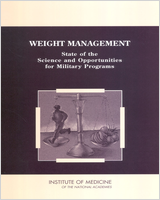NCBI Bookshelf. A service of the National Library of Medicine, National Institutes of Health.
The primary purpose of fitness and body composition standards in the U.S. Armed Forces has always been to select individuals best suited to the physical demands of military service, based on the assumption that proper body weight and composition supports good health, physical fitness, and appropriate military appearance.
The current epidemic of overweight and obesity in the United States affects the military services. The pool of available recruits is reduced because of failure to meet body composition standards for entry into the services and a high percentage of individuals exceeding military weight-for-height standards at the time of entry into the service leave the military before completing their term of enlistment.
To aid in developing strategies for prevention and remediation of overweight in military personnel, the U.S. Army Medical Research and Materiel Command requested the Committee on Military Nutrition Research to review the scientific evidence for: factors that influence body weight, optimal components of a weight loss and weight maintenance program, and the role of gender, age, and ethnicity in weight management.
Contents
- THE NATIONAL ACADEMIES
- SUBCOMMITTEE ON MILITARY WEIGHT MANAGEMENT
- COMMITTEE ON MILITARY NUTRITION RESEARCH
- FOOD AND NUTRITION BOARD
- Reviewers
- Preface
- Executive Summary
- 1. Background and Context of the Overweight Problem
- 2. Military Standards for Fitness, Weight, and Body Composition
- 3. Factors That Influence Body Weight
- 4. Weight-Loss and Maintenance Strategies
- 5. Response to the Military's Questions
- 6. Programmatic and Research Recommendations
- References
- A Workshop Agenda and Abstracts
- B Biographical Sketches of the Workshop Speakers
- C Biographical Sketches of the Subcommittee on Military Weight Management
- D Acronyms
Support for this project was provided by U.S. Army Medical Research and Materiel Command through contract no. DAMD17-99-1-9478. The U.S. Army Medical Research Acquisition Activity, 820 Chandler Street, Fort Detrick, MD 21702-5014, is the awarding and administering acquisition office. The views presented in this report are those of the Subcommittee on Military Weight Management and are not necessarily those of the funding agency.
NOTICE: The project that is the subject of this report was approved by the Governing Board of the National Research Council, whose members are drawn from the councils of the National Academy of Sciences, the National Academy of Engineering, and the Institute of Medicine. The members of the committee responsible for the report were chosen for their special competences and with regard for appropriate balance.
- Review Body composition and military performance--many things to many people.[J Strength Cond Res. 2012]Review Body composition and military performance--many things to many people.Friedl KE. J Strength Cond Res. 2012 Jul; 26 Suppl 2:S87-100.
- Body fat standards and individual physical readiness in a randomized Army sample: screening weights, methods of fat assessment, and linkage to physical fitness.[Mil Med. 2002]Body fat standards and individual physical readiness in a randomized Army sample: screening weights, methods of fat assessment, and linkage to physical fitness.Friedl KE, Leu JR. Mil Med. 2002 Dec; 167(12):994-1000.
- Review The obesity epidemic: implications for recruitment and retention of defence force personnel.[Obes Rev. 2009]Review The obesity epidemic: implications for recruitment and retention of defence force personnel.McLaughlin R, Wittert G. Obes Rev. 2009 Nov; 10(6):693-9. Epub 2009 May 21.
- The Army Weight Control Program: a comprehensive mandated approach to weight control.[J Am Diet Assoc. 1985]The Army Weight Control Program: a comprehensive mandated approach to weight control.Rinke WJ, Herzberger JK, Erdtmann FJ. J Am Diet Assoc. 1985 Nov; 85(11):1429-36.
- Unfit for service: the implications of rising obesity for US military recruitment.[Health Econ. 2012]Unfit for service: the implications of rising obesity for US military recruitment.Cawley J, Maclean JC. Health Econ. 2012 Nov; 21(11):1348-66. Epub 2011 Oct 4.
- Weight ManagementWeight Management
Your browsing activity is empty.
Activity recording is turned off.
See more...
